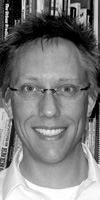|
Subscribe / Renew |
|
|
Contact Us |
|
| ► Subscribe to our Free Weekly Newsletter | |
| home | Welcome, sign in or click here to subscribe. | login |
Construction
| |
 |
October 5, 2006
A vision of South Lake Union in 2020
University of Washington

Born
|
You remember the days when this street was a pedestrian barrier instead of a magnet. You remember when Mercer Street was a “mess” to be avoided. Now it thrives with activity — cars and buses move smoothly to I-5 while joggers, shoppers and pedestrians go about their day on the reconstructed Valley Street. Bicycles, Segways and scooters zip along — mostly on Valley, and the streetcar connects the neighborhood to the city’s mass transit network. Construction has already begun to extend the streetcar on both ends.
What are we talking about here? Is this a reasonable vision for one of the most rapidly changing neighborhoods in Seattle?
I think it is. Let’s examine what South Lake Union will look like in the year 2020, based on city development trends, job and housing projections, and a variety of neighborhood plans.
New construction
The most noticeable thing will be the parking lots — that is, the reduction of them, and the redevelopment of underused properties. With recent zoning changes downtown and in South Lake Union, the city will be taller, denser and have more mixed uses.
In South Lake Union, many buildings that are economically not viable for renovation or are of no architectural significance will be gone, replaced by taller, greener and more attractive buildings that accommodate many potential uses.
Other facilities will be renovated, adaptively reused or preserved for their historic character as well as their functionality — think of the Zymogenetics and Shurgard properties on Eastlake Avenue.
There will be more economic activity in South Lake Union, too. This neighborhood has historically functioned as an industrial center and support system, and this will continue but with a different look and feel.
Business growth
The industry mix will change — biotechnology and medical sciences will continue to grow, as will technology firms and University of Washington-related business startups and support services. Spaces designed for biotech firms are relatively flexible, perhaps emblematic of the dynamism of the industry itself.
Fortunately for South Lake Union, the specially designed industrial space will support biotech development without excluding a variety of light-industrial, manufacturing and high-tech uses in 2020. These firms will contribute to job growth that, while different in form from Microsoft and Boeing, will still be significant to the region.
Many of the new businesses will contribute to and benefit from the South Lake Union Business Improvement District, which provides a networking and problem-solving forum, additional services such as sidewalk and street furniture maintenance, and neighborhood ambassadors to help tourists navigate the neighborhood.
In addition, there will be more restaurants, coffee shops and food retailers to support residents and daytime employees. The growth of food services will increase the number of service and manufacturing jobs, contributing to the 20,000 jobs projected by 2024 in the city’s South Lake Union Neighborhood Plan.
Other services that support the new population will provide jobs and urban amenities, giving the neighborhood an active, lived-in feel — it will be both an employment center and a residential center. South Lake Union will have a new elementary school and perhaps a Gates Foundation-supported magnet high school focused on science and technology.
Thriving parks
In terms of recreation and culture, the neighborhood will house a few city gems. The most popular will be South Lake Union Park, which will reconnect people in the neighborhood with the waterfront. Seattle’s maritime heritage will be felt throughout, and the Center for Wooden Boats will continue to be an anchor to the park and the area’s cultural heritage.
Two other parks will be thriving. Cascade Park will serve as a social center, with school kids exploring during the day and neighborhood residents relaxing, walking dogs and socializing in the afternoons and evenings.
The renovated Denny Park will be similar, but feature a weekend farmers market and daily lunch activity with ethnic food carts serving local employees. The thinning of some of the trees will allow more light into the park, literally casting the space in a whole new light, making it more welcoming at all hours.
A new P-patch will be an active weekend hub, bringing together community residents. Galleries will cluster around the neighborhood, the Museum of History and Industry will move into the South Lake Union Park armory, and a new neighborhood service center will work with community groups such as the Cascade Neighborhood Council and South Lake Union Friends and Neighbors to provide access to city services or coordinate local art and music events.
South Lake Union will develop more quickly and in a richer way than its older sibling, Belltown. The industrial and working history of the neighborhood, and the commitment of major actors such as the city of Seattle, Vulcan, Cascade Neighborhood Council and South Lake Union Friends and Neighbors, are all contributing to this diverse growth. A focus on functionality and the future while maintaining the cultural and social identity of the past has been a hallmark of the neighborhood’s revival.
How accurate is this vision? We won’t have to wait too long to find out.
Branden Born is an assistant professor in the Department of Urban Design and Planning at the University of Washington.
Other Stories:
- Park work restores link to the lake
- City seizing its chance to build an urban oasis
- 2200: New life for an emerging neighborhood
- Vulcan plans a 'thriving' mixed-use community


